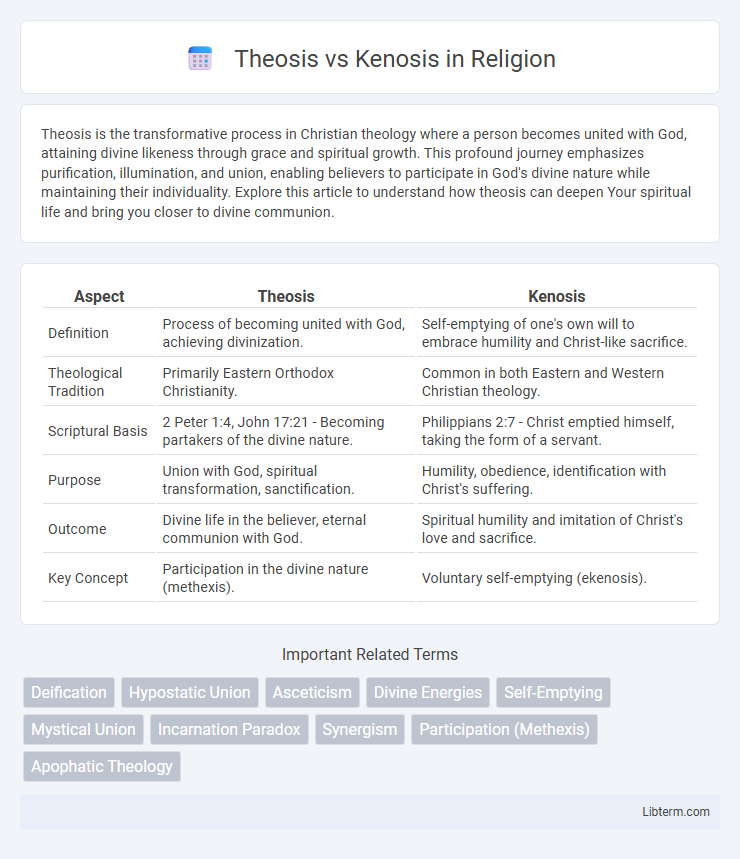Theosis is the transformative process in Christian theology where a person becomes united with God, attaining divine likeness through grace and spiritual growth. This profound journey emphasizes purification, illumination, and union, enabling believers to participate in God's divine nature while maintaining their individuality. Explore this article to understand how theosis can deepen Your spiritual life and bring you closer to divine communion.
Table of Comparison
| Aspect | Theosis | Kenosis |
|---|---|---|
| Definition | Process of becoming united with God, achieving divinization. | Self-emptying of one's own will to embrace humility and Christ-like sacrifice. |
| Theological Tradition | Primarily Eastern Orthodox Christianity. | Common in both Eastern and Western Christian theology. |
| Scriptural Basis | 2 Peter 1:4, John 17:21 - Becoming partakers of the divine nature. | Philippians 2:7 - Christ emptied himself, taking the form of a servant. |
| Purpose | Union with God, spiritual transformation, sanctification. | Humility, obedience, identification with Christ's suffering. |
| Outcome | Divine life in the believer, eternal communion with God. | Spiritual humility and imitation of Christ's love and sacrifice. |
| Key Concept | Participation in the divine nature (methexis). | Voluntary self-emptying (ekenosis). |
Introduction to Theosis and Kenosis
Theosis refers to the transformative process in Christian theology where believers become more like God through divine grace, embodying holiness and union with the divine nature. Kenosis describes Christ's self-emptying, as depicted in Philippians 2:7, where He relinquished divine privileges to fully embrace human limitations and serve humanity. Understanding the distinction between Theosis and Kenosis is essential for grasping core doctrines of incarnation, salvation, and spiritual growth in Eastern Orthodox and Christian theology.
Defining Theosis: Becoming One with God
Theosis is the transformative process in Eastern Orthodox theology where a believer becomes one with God through participation in the divine nature, emphasizing union and deification rather than mere moral improvement. This concept highlights the restoration of the image of God within humans, allowing them to attain likeness to God by grace. Unlike Kenosis, which involves Christ's self-emptying for humanity's salvation, Theosis centers on the believer's spiritual ascent and communion with God's uncreated energies.
Understanding Kenosis: Self-Emptying in Christianity
Kenosis in Christian theology defines the self-emptying of Jesus Christ's divine attributes to fully embrace human limitations, as described in Philippians 2:7. This concept emphasizes humility and sacrificial love, where divine power is voluntarily relinquished to achieve redemption and communion with humanity. Understanding Kenosis highlights the transformative nature of Christ's incarnation, contrasting with Theosis, which centers on the believer's participation in divine life.
Scriptural Foundations for Theosis and Kenosis
Theosis finds its Scriptural foundation in passages such as 2 Peter 1:4, which speaks of becoming "partakers of the divine nature," emphasizing the transformative union with God. Kenosis is rooted in Philippians 2:7, where Christ "emptied himself" by taking on human form, highlighting humility and self-emptying love. These foundational texts frame the theological dialogue on human divinization versus Christ's self-limitation in the Incarnation.
Theosis in Eastern Orthodox Theology
Theosis in Eastern Orthodox theology emphasizes the transformative process by which believers participate in the divine nature, aiming for union with God through grace and spiritual purification. This concept contrasts with Kenosis, which centers on Christ's self-emptying for the sake of humanity's salvation. Theosis highlights the potential for human divinization, integral to Orthodox spirituality and soteriology.
Kenosis in Western Christian Thought
Kenosis in Western Christian thought emphasizes Christ's self-emptying of divine privileges to fully embrace human experience, highlighting humility and obedience as key theological virtues. This concept contrasts with Theosis, which centers on the transformative union with God predominantly explored in Eastern Christianity. Western theology often interprets Kenosis through Pauline texts such as Philippians 2:7, underscoring the incarnation's sacrificial and redemptive dimensions.
Comparing Theosis and Kenosis: Key Differences
Theosis and Kenosis represent distinct theological concepts centering on divine-human interaction, where Theosis involves the transformative process of becoming godlike through union with God's energies, and Kenosis emphasizes Christ's self-emptying of divine privileges to fully embrace humanity. The key difference lies in their focus: Theosis highlights participation in divine nature to achieve spiritual divinization, while Kenosis stresses humility and self-renunciation as Christ's method of incarnation and redemption. These concepts underscore complementary but contrasting dimensions of salvation, divine immanence, and human sanctification in Christian theology.
The Interconnection between Theosis and Kenosis
Theosis and Kenosis are intrinsically connected in Christian theology, where Theosis refers to the process of becoming united with God, and Kenosis represents the self-emptying of Christ to enable this union. Kenosis serves as the foundation for Theosis by illustrating how humility and self-sacrifice open the path for divine transformation in believers. This interconnection highlights that human participation in Theosis is possible through imitating Christ's kenotic love and surrender.
Practical Implications for Christian Spirituality
Theosis emphasizes the transformative union with God, encouraging believers to pursue holiness and divine likeness through prayer, sacraments, and virtuous living, which fosters spiritual maturity and deeper communion with God. Kenosis involves self-emptying and humility, guiding Christians to imitate Christ's sacrificial love by embracing vulnerability, service, and detachment from ego, enhancing spiritual growth and relational harmony. Integrating theosis and kenosis leads to practical Christian spirituality that balances divine participation with selfless humility, promoting holistic transformation and authentic discipleship.
Theosis and Kenosis in Contemporary Theology
Theosis in contemporary theology emphasizes the transformative union between humanity and the divine, highlighting spiritual growth through participation in God's nature as seen in Eastern Orthodox traditions. Kenosis, rooted in Philippians 2:7, focuses on Christ's self-emptying and humility, serving as a model for ethical living and divine-human relationship. Modern theological discourse explores the dynamic interplay of Theosis and Kenosis to understand salvation, sanctification, and the human vocation toward divine likeness.
Theosis Infographic

 libterm.com
libterm.com